IPPHL Impact Report by Evans School
Author: Liz Steen
Deploying CHWs to Decrease Severe Acute Malnutrition in South Africa
From 2016 to 2021, the public health department in Limpopo Province, South Africa built a community health worker program that reduced the fatality rate in cases of severe acute malnutrition in children in their first 1000 days from 21.5% to 7.5%. Severe acute malnutrition (SAM) is a major issue across Sub-Saharan Africa and is associated with 30.9% of South Africa’s audited under-five children deaths.
Mr. Daddy Matthews, Deputy Director of Nutrition Services for the Department of Health in Limpopo, South Africa, recognized that Community Health Workers (CHWs) were an underutilized resource in the fight to combat neonatal and child malnutrition. The 1,226 CHW’s in Limpopo Province, primarily tasked with performing HIV/AIDs-related activities, were inadequately trained, not regarded as departmental personnel because they were managed by NGOs, and insufficiently compensated with only a small stipend.
Mr. Matthews recognized an opportunity to both address the high rates of malnutrition and to improve the morale and skills of CHWs in Limpopo Province. First, Mr. Matthews and his team developed an integrated framework to guide their work, the Limpopo Neonatal, Maternal, and Child Health Nutrition Framework. Using this framework, they trained CHWs and NGOs on infant and young child feeding, malnutrition detection, and management of foodborne illnesses. They established teams, known as “children’s clubs,” that were trained in essential skills, including identifying severe acute malnutrition using mid-upper arm circumference (MUAC) tapes, recognizing pregnant women, detecting children with vitamin deficiencies, and connecting mothers with South Africa’s child’s grant. To incentivize performance and boost motivation, Mr. Matthews and his team introduced a competitive element, where teams earned points based on their community outreach success and were awarded prizes. CHWs received formal recognition as Department of Health personnel, receive direct payment and have access to departmental resources. Since implementing this framework, case fatality rates due to Severe Acute Malnutrition have plummeted.
To develop and implement this new framework, Mr. Matthews drew on a number of skills gained through IPPHL, including implementation analysis using theory of change, stakeholder engagement and collaboration, behavioral incentives for program design, and performance assessment to monitor progress and adjust program strategy.
Strengthening Kenya’s Vaccine Safety Reporting System: increased AEFI reporting in Kenya
Dr. Lucy Mecca achieved remarkable success in strengthening Kenya’s vaccine safety reporting system. Vaccine safety systems and adequate reporting of Adverse Events Following Immunization (AEFI) are essential as they allow public health officials to enhance confidence in immunization programs. In just under two years, Dr. Mecca and her team improved reporting structures and increased the number of reported cases of AEFI from just twelve cases in 2019 and eighteen cases in 2020, to 861 cases in 2021. Dr. Lucy and her team have continued to strengthen this system with 3,251 AEFI cases reported in 2023.
In Kenya, vaccine safety monitoring systems were inadequate and failed to meet the World Health Organization’s surveillance targets of at least 10 reports of Adverse Events Following Immunization (AEFI) per 100,000 infants, with only 20 reports annually from a population of about 1.5 million infants. This underperformance resulted in a lack of robust data on vaccine safety and heightened the risk of rumors, misinformation, vaccine-hesitancy, and conspiracy theories, especially with new vaccines.
Improving vaccine reporting is critical as new vaccines are introduced but is a complex challenge because it involves a diverse set of entities including regulators, public health agencies and the WHO. Dr. Mecca used the introduction of the malaria and COVID-19 vaccines as a window of opportunity to bring stakeholders together to strengthen Kenya’s vaccine safety. She used her skills in stakeholder engagement to focus first on strengthening collaboration with the regulator. This allowed her team to revise health worker training programs to include AEFI, develop and disseminate AEFI reporting guidelines, conduct active AEFI surveillance, and establish the National Vaccines Safety Advisory Committee. Dr. Mecca, working with the regulator, also oversaw the introduction of a new online reporting system which allowed patients to submit AEFI directly without relying on health workers to report. This was particularly effective during the COVID-19 vaccine rollout. Additionally, Dr. Mecca’s team integrated a specialized AEFI reporting module into the regulator’s existing online system. This enhancement allowed for more accurate and comprehensive reporting of vaccine-related adverse events, addressing limitations in the previous drug-focused system.
To implement the overhaul of Kenya’s vaccine safety reporting system, Dr. Mecca drew on policy and leadership skills gained through IPPHL, including stakeholder engagement, team collaboration, efficient resource deployment, implementation analysis and process improvement. The policy memo she developed as part of the IPPHL program played a critical role in analyzing the problems affecting AEFI surveillance and helped her to think creatively about accessing resources. She was ultimately able to implement many of her recommendations.
Achieving 71% HPV Vaccination Coverage in Nigeria

In under two years, Nigeria has achieved a 71% national Human Papilloma Virus (HPV) vaccination coverage rate for girls aged 9-14, resulting in the vaccination of over 12 million girls across the country. The HPV vaccine can prevent more than 90% of cases of cervical cancer, the second deadliest cancer among women aged between 15 and 44 in Nigeria. This translates into potentially preventing up to 10,000 new cases and 7,000 deaths annually.
Dr. Njideka Kanu, an Epidemiologist with the National Primary Healthcare Development Agency (NPHCDA) and an IPPHL Cohort 6 alumna, led the national team to support the vaccine introduction in Anambra and Delta States and played a crucial role in integrating the (HPV) vaccine into Nigeria’s national immunization program.
Dr. Kanu has been instrumental in the vaccine’s integration into the national immunization program. She and her team at the NPHCDA built a massive coordination effort at the national, state, and local levels. National representatives worked closely with state teams to develop strategies to reach girls in schools, places of worship, and communities, with special attention placed on hard-to-reach areas. The team engaged in a public awareness campaign through press engagements, radio jingles, and sensitization sessions. Finally, they developed a uniform micro-planning template that was shared across states for consistency and conducted training at the national, state, and local government levels for health workers, vaccinators, recorders, town announcers, and community leaders. The vaccine rollout was officially launched on May 27, 2023, coinciding with Children’s Day in Nigeria. The launch, led by the first ladies of each state, aimed to maximize visibility and impact. Dr. Kanu and her team followed with a nationwide campaign targeting schools, communities, and places of worship for the next 4 to 5 days.
Dr. Kanu’s skills in stakeholder mapping, advocacy, and communication enabled her team to identify and prioritize key players, secure resources from high-level stakeholders, coordinate the vaccine rollout, and deploy effective advocacy strategies for addressing vaccine-hesitancy.
In an interview with IPPHL , Njideka highlights how her training as a public health physician and a field epidemiologist has helped shaped the way she works now, especially in health system management and outbreak response. She plays a pivotal role in the Department of Disease Control and Immunization where her responsibilities include strengthening primary healthcare systems with a focus on disease control and immunization efforts in Nigeria. Please watch here.
Full IPPHL Community Convenes for first ever Summit in Nairobi, Kenya
This Summit represents the first ever gathering of more than 150 alumni of the IPPHL program, representing 29 African countries and spanning all areas of public health. Our Summit theme, “Leadership, Policy, and Action for Resilient Health Systems in Africa” reflects IPPHL’s mission of expanding the policy and leadership acumen of public health leaders to develop and implement lasting public policy solutions and transform health systems.
To date, six cohorts of fellows have completed the program, but the Summit is our first in-person gathering of all cohorts and the first time our all-virtual Cohorts 4 and 5 are convening in person. Over the past year, alumni worked collaboratively with the IPPHL team to plan and develop the Summit agenda in response to your goals. Deep thanks go to all alumni who contributed time and expertise to developing this transformative program.
Over the three days of the Summit, participants deepened relationships across cohorts, built robust networks to deepen impact, and welcomed other global health experts. Together the community co-created a shared strategy for future action to amplify our work to strengthen public health systems and population health and well-being.
The COVID-19 pandemic underlined the critical role of resilient country-level public health systems in supporting the health and security of their populations. The pandemic also underscored the importance of regional and continent-wide strategies for global health security. The growing network of over 150 IPPHL Alumni are well positioned to lead the next generation of public health strategies to build more equitable and resilient health systems across the African continent.
Watch the short clip below from the Summit, and check back often as the team reports out on this momentous event.
Public Health Leadership During COVID-19
In November 2021, four IPPHL alumni took a moment of pause to discuss how they have been leading and sustaining themselves and their teams through the pandemic.
Panelists included Selorm Kutsoati, Ikrama Hassan, Joel Mubiligi, and Lucy Mecca and the conversation was facilitated by Nosa Orobaton.
Our four panelists discussed their challenges in response to COVID-19, including managing the changing work environment and skepticism surrounding the novel pandemic and vaccines. The group’s greatest successes included the resilience of staff and health systems, the maintenance of routine immunization services, and the mobilization of health workers.
Across the board, leadership skills have been crucial to their response, especially in uncertain and constantly evolving circumstances. The public relates better to a leader who communicates transparently, refrains from overconfidence, speaks with an honest and humanistic approach, is able to adjust their leadership style, and includes input from others.
Joel highlighted the importance of collaborative leadership in caring for geographically dispersed chronic care patients during the lockdown. His team partnered with other organizations to coordinate drug delivery to high-risk patients. This specific challenge forced his team to work effectively through uncertainty, make decisions quickly, and center the human in all of their decisions.
The pandemic highlighted the inequities both within the panelists’ health systems and globally. Dr. Kutsoati shone a light on how large cities have generally received better access and better care during COVID and more rural areas lacked funding and operational support. On an international scale, Dr. Ikrama discussed the world as a globalized village. The hoarding of vaccines and other resources by western countries and the limitations of vaccine intellectual property is resulting in the prolongation of the pandemic globally. “Whatever the rich world is doing, they are not likely to succeed in getting rid of COVID-19 until the poorest part of the world is safe.” – Dr. Ikrama Hassan
Broadly speaking, COVID has revealed what has been happening on the ground for centuries and has reinforced the need for primary health care and universal health coverage. The pandemic has also given us a window and opportunity to use the resources that we do have to change our health systems. Panelists recommended looking inward at what is already being started and practiced in Africa, such as a burgeoning vaccine development program and nurturing relationships with local health organizations.
The Public Leadership During COVID-19: Conversation with Public Health Leaders from across Africa panel was a collaboration with the International Program in Public Health Leadership (IPPHL), the Bill and Melinda Gates Foundation, and the Public Health Initiative at the University of Washington. Panelists included Dr. Selorm Kutsoati, Dr. Ikrama Hassan, Joel Mubiligi, and Lucy Mecca and was facilitated by Nosa Orobaton.
National Nutrition and Obesity Week: Good Nutrition for Good Immunity
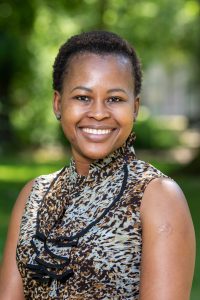 The IPPHL team recently had the chance to have a conversation with Ms. Rebone Ntsie, a Cohort 2 Fellow, about her work and the influence IPPHL has had on her growth as a leader. As the Nutrition Director at the National Department of Health, South Africa, Rebone recently led the 2020 National Nutrition and Obesity Week, and shared some of her insights on the campaign with us.
The IPPHL team recently had the chance to have a conversation with Ms. Rebone Ntsie, a Cohort 2 Fellow, about her work and the influence IPPHL has had on her growth as a leader. As the Nutrition Director at the National Department of Health, South Africa, Rebone recently led the 2020 National Nutrition and Obesity Week, and shared some of her insights on the campaign with us.
Could you give us a brief overview of the campaign and the goals you aimed to achieve?
We have had this campaign every year for at least two decades now. It has been documented on the website nutritionweek.co.za since 2011. And this year it was around June that we started to say look we need to focus on COVID, but what about COVID? Nutrition was very important. People everywhere were talking about boosting your immune system, but not really understanding how to do so, and getting a lot of misinformation. So we wanted to guide the public in terms of what is critical.
One of the issues that came across very strong was that of food insecurity. In our country we have always known that we have food insecurity, but during COVID it became much clearer. Some people could no longer go to work, they didn’t have anything to eat. And what was concerning is that we knew already that those people who are worst affected by COVID are those that have NCDs. We know that unhealthy diet is one of the major risk factors for NCDs. We also know that the immune system is affected by nutrition, hence the theme of the campaign was Good Nutrition for Good Immunity.
We wanted to use this opportunity to assist people in terms of what they can actually do to boost their immune system. We emphasized the health benefits of choosing healthy whole foods from a variety of mostly plant-based foods such as vegetables and fruit, legumes and minimally processed starchy foods, encouraged consumers to make healthy, affordable food choices and most importantly we provided 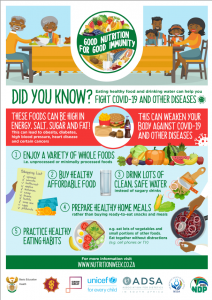 consumers with practical tips when planning, buying, preparing and eating food during and after the COVID-19 pandemic. And we included messages on promotion of breastfeeding, which we know is the most nutritious and affordable food for infants and young children. So those are the tips we focused on. Educating people about healthier food choices, how to buy healthy food with less income. Speaking a lot on home cooked meals, with recipes and tips on how to buy in bulk. We even had a two week menu with a list of groceries, and one of the organizations we worked with had developed nutrient dense recipes with affordable foods. Just to give people practical tips. And I think it resonated well with a lot of people. We wanted to educate them that boosting your immune system is not this thing that you do today; you drink this concoction, and your immune system is boosted. It’s something you need to invest in, that you need to do continuously.
consumers with practical tips when planning, buying, preparing and eating food during and after the COVID-19 pandemic. And we included messages on promotion of breastfeeding, which we know is the most nutritious and affordable food for infants and young children. So those are the tips we focused on. Educating people about healthier food choices, how to buy healthy food with less income. Speaking a lot on home cooked meals, with recipes and tips on how to buy in bulk. We even had a two week menu with a list of groceries, and one of the organizations we worked with had developed nutrient dense recipes with affordable foods. Just to give people practical tips. And I think it resonated well with a lot of people. We wanted to educate them that boosting your immune system is not this thing that you do today; you drink this concoction, and your immune system is boosted. It’s something you need to invest in, that you need to do continuously.
What additional challenges did COVID present?
The campaign is in October, so from January, we were already thinking and starting to prepare. What was different this year? We had prepared the concept document, and already started working on evidence, agreed on what we want to focus on, which was nutrition labeling. Then come March, we realized that COVID is becoming serious. We continued thinking maybe by June it will have ended, but around May we realized we would be appearing stupid, to be honest, if come October we’re still talking about nutrition labeling when people are 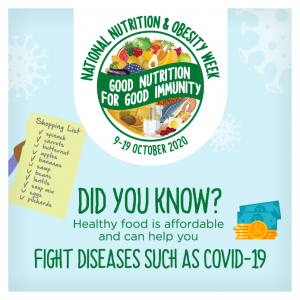 concerned about COVID. So we needed to be relevant.
concerned about COVID. So we needed to be relevant.
We’re also used to having these physical events, and especially in local events, we usually gather people to do demonstrations and exhibitions. So we were not sure about how then to do this campaign. On our own, honestly, we wouldn’t have managed, but because we had different people in the team with different expertise, that helped us a lot. For example, one of the target groups we wanted to reach was youth and through UNICEF we managed to get them involved as well, and to use methods that are exciting to them. UNICEF has 2,000 volunteers across universities, and we prepared material for them to share easily. The material was also sent to dietetics university students to share. And I can tell you that we received a lot of financial support for this campaign. We could actually get organizations that we were working with to invest in our campaign, because they saw it as a benefit for them as well. It was at a time when everybody really wanted to contribute.
What was your role in the campaign?
My main role was to provide strategy and leadership; guiding all collaborators in terms of what to do, what’s next, and how to get there. What I was doing was mainly coordinating all the activities, chairing all the meetings, and negotiating with different organizations. But it was truly a team effort to bring the campaign to fruition. I would certainly want to recognize my colleague, Ms. Maude de Hoop, who was the secretariat of the whole campaign and played a major role in the creation of essential materials such as the concept document and Q&A.
What were some of the organizations you worked with?
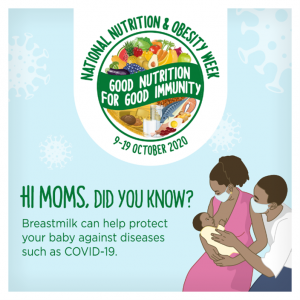 Besides the Department of Health in all provinces in the country and the South African Military Health Service (SAMHS), we had a lot of non-governmental organizations we had already worked with (Association of Dietetics in South Africa, Nutrition Society of South Africa, Heart and Stroke Foundation SA, Cancer Association of SA, Consumer Goods Council SA), and new ones (Grow Great, UNICEF, Clinton Health Access Initiative). We also had two individual volunteers. Ms. Liezel Engelbrecht who volunteered to develop the communications strategy, was involved with us for the first time as well. So, some were new but they did an excellent job.
Besides the Department of Health in all provinces in the country and the South African Military Health Service (SAMHS), we had a lot of non-governmental organizations we had already worked with (Association of Dietetics in South Africa, Nutrition Society of South Africa, Heart and Stroke Foundation SA, Cancer Association of SA, Consumer Goods Council SA), and new ones (Grow Great, UNICEF, Clinton Health Access Initiative). We also had two individual volunteers. Ms. Liezel Engelbrecht who volunteered to develop the communications strategy, was involved with us for the first time as well. So, some were new but they did an excellent job.
We also have been working with the Department of Basic Education for some time because school-going children have always been one of our targets. But for the first time this year we also worked with the Department of Social Development, because we knew that food insecurity is an issue and they are the ones responsible for social protection measures. A lot of their clients are on social relief programmes, so these are the people that are worst hit. We thought a lot about how we can package this in a way that’s sensitive to the needs of these people, and about how do we include them in our campaign? So Social Development came in very handy to really reach people that we usually don’t reach and that need us most.
How did you balance all the different organizations?
What was key was to reach consensus, which frustrated some of our collaborators, especially the new ones who were not familiar with how we work. It takes a little bit of time to reach consensus but for us that is important because once all of us have bought in we are all able to move forward on the same page. We needed to make sure we were all aligned and communicating the same messages. We used tested messages, we didn’t just take them from anywhere, so this was very important.
We also created a collaborators checklist because we wanted all collaborators right from the beginning to indicate who they were, what their role would be, what we should expect from them in this campaign, and declaration of any conflicts of interest. And that’s something that worked well and we plan to build on it and make it even better.
Could you tell me a little more about your plans for evaluation of the campaign?
We have always wanted to have a proper M&E framework to look at what it is we want to achieve and check at the end of the campaign if we’ve done that. We lack the resources and capacity to do it, but it’s something we still want to do. However, now on an annual basis we have a feedback meeting to see how the campaign went in terms of material, if things happened on time, and what we can do better next year. For the first time this year we have the informal measures about what we’ve done. We developed a short template that our collaborators can fill out to give us an idea of what happened, how many people we reached, where, and so on. Also for the first time this year a team of experts piloted a tool they have developed to do a Social Behavioral Communication Change (SBCC) evaluation on our campaign. We are hoping this campaign changes behavior, but we don’t have the mechanisms to check if it really does. So the SBCC evaluation will identify opportunities for improving the campaign in the future in terms of planning, designing, implementation, and monitoring and evaluation.
What skills did you gain from IPPHL that you found relevant or useful for the campaign?
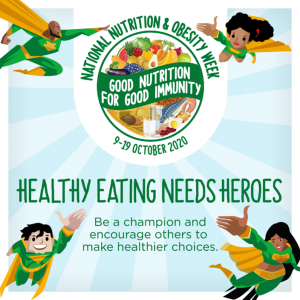 Bringing in organizations reminded me of the elevator pitch that we did. Because one had to think quickly to identify the relevant organization and what to say. The stakeholder analysis that we did as well; who are the stakeholders, who are likely to bring progress rather than derail, and defining their role. And then with that I could then be able to explain to them what this campaign is, how it enhances the work that they’re doing, and what type of help we need from them. And they did even more than we could have expected within a very short period of time.
Bringing in organizations reminded me of the elevator pitch that we did. Because one had to think quickly to identify the relevant organization and what to say. The stakeholder analysis that we did as well; who are the stakeholders, who are likely to bring progress rather than derail, and defining their role. And then with that I could then be able to explain to them what this campaign is, how it enhances the work that they’re doing, and what type of help we need from them. And they did even more than we could have expected within a very short period of time.
I think more than any one thing that I learned from IPPHL, what IPPHL has done for me was to provide me with the confidence that I needed. In IPPHL I have been given the skills and have been capacitated to lead and influence others. So, I knew what to do, and I was confident in what I was doing. I think because of that I was able to work with others very well and inspire passion in people; really influence them to drive the change that we all want to see. This program really has benefited me; it has enriched me I must say.
Have you interacted with the other IPPHL alumni near you?
I used to work with Mr. Daddy Matthews at the provincial level, and now I moved to national, but we collaborate on a very regular basis. We exchange information and plan activities. And Dr. Eva Mulutsi is my friend; we work at the national level together. We don’t work together closely because she works in forensic mental health, but we support each other in terms of strategy and management issues and leadership; share ideas and draw on each other.
Do you have any advice for women looking to become leaders in public health?
The main thing for me is I think as women we don’t have to doubt ourselves. We have the capacity to lead. And let me mention one thing that came very handy from IPPHL: adaptability. In your mind you know that things are not stagnant; and so you have to think of when you will need to adapt and how to do that. And that’s one thing that’s prepared me. I wasn’t resistant to change and I can tell you that all technical staff in the nutrition directorate have now adapted to working from home remotely. We came up with tools and we actually think that maybe we should continue this way because we have adapted to these new ways of working. One of the things that I still do is I read the articles from CCL, and a lot of material that they post talks about change, adapting in the environment, so that has also helped me. And some of those things I share with colleagues as well.